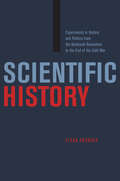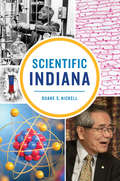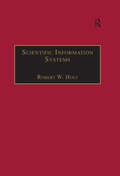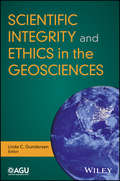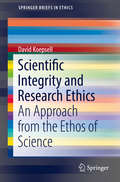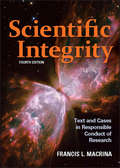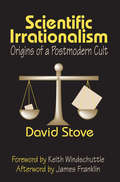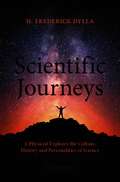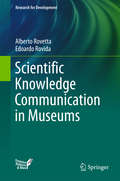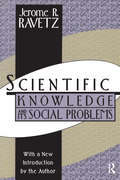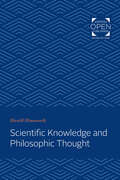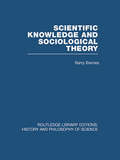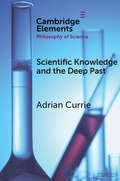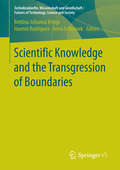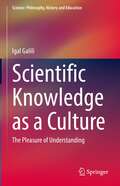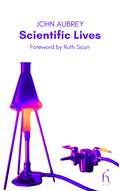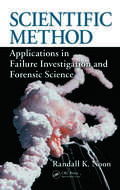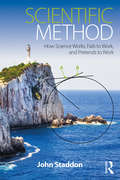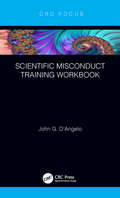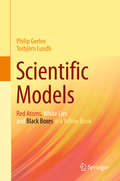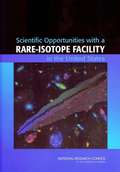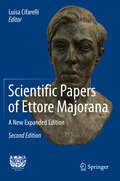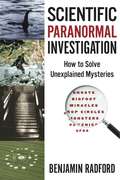- Table View
- List View
Scientific History: Experiments in History and Politics from the Bolshevik Revolution to the End of the Cold War
by Elena AronovaIncreasingly, scholars in the humanities are calling for a reengagement with the natural sciences. Taking their cues from recent breakthroughs in genetics and the neurosciences, advocates of “big history” are reassessing long-held assumptions about the very definition of history, its methods, and its evidentiary base. In Scientific History, Elena Aronova maps out historians’ continuous engagement with the methods, tools, values, and scale of the natural sciences by examining several waves of their experimentation that surged highest at perceived times of trouble, from the crisis-ridden decades of the early twentieth century to the ruptures of the Cold War. The book explores the intertwined trajectories of six intellectuals and the larger programs they set in motion: Henri Berr (1863–1954), Nikolai Bukharin (1888–1938), Lucien Febvre (1878–1956), Nikolai Vavilov (1887–1943), Julian Huxley (1887–1975), and John Desmond Bernal (1901–1971). Though they held different political views, spoke different languages, and pursued different goals, these thinkers are representative of a larger motley crew who joined the techniques, approaches, and values of science with the writing of history, and who created powerful institutions and networks to support their projects. In tracing these submerged stories, Aronova reveals encounters that profoundly shaped our knowledge of the past, reminding us that it is often the forgotten parts of history that are the most revealing.
Scientific Indiana
by Duane S. NickellScientists who lived, worked or were educated in the Hoosier State have made fundamental contributions to astronomy, biology, chemistry and physics. Astronomer Vesto Slipher discovered that almost all other galaxies were moving away from our own Milky Way Galaxy. Biologist Alfred Kinsey was a pioneer in the field of human sexuality. Chemist Harold Urey discovered deuterium and worked on the Manhattan Project. And physicist Edward Purcell discovered nuclear magnetic resonance, the basis for MRI, one of the most significant medical advances in a century. Scientists with Indiana connections have also been awarded a dozen Nobel Prizes. Hoosier science teacher Duane S. Nickell offers a glimpse into the lives of seventeen scientific heroes from Indiana.
Scientific Information Systems
by Robert W. HoltSafety critical jobs in fields such as aviation and nuclear power plants require a careful and comprehensive analysis of all factors relevant to critical job performance. Understanding how these factors uniquely and in combination, affect performance requires interconnecting a job performance database with several other information databases. The scientific method is necessary to ensure information quality; to solve problems or project trends; and to correctly evaluate changes in selection, training, performance evaluation, the person-machine interface, or team dynamics. Combining the scientific method with the construction, validation and use of the information databases results in a Scientific Information System (SIS), which joins practical utility with powerful evauations of relevant theories. This book discusses how to blend scientific methods with the broad capabilities of computer database information systems. This synthesis will aid anyone who is trying to explain, predict, or change the behavior of a complex system involving humans. Whilst developed from research on information systems in the aviation industry, the principles and methods are universal and the book provides conceptual guidance for the construction and use of such systems in other domains. The examples clarify the advantages of this type of information system and the enormous potential power for understanding a target system completely and accurately.
Scientific Integrity and Ethics in the Geosciences
by Linda C. GundersenScience is built on trust. The assumption is that scientists will conduct their work with integrity, honesty, and a strict adherence to scientific protocols. Written by geoscientists for geoscientists, Scientific Integrity and Ethics in the Geosciences acquaints readers with the fundamental principles of scientific ethics and shows how they apply to everyday work in the classroom, laboratory, and field. Resources are provided throughout to help discuss and implement principles of scientific integrity and ethics. Volume highlights include: Examples of international and national codes and policies Exploration of the role of professional societies in scientific integrity and ethics References to scientific integrity and ethics in publications and research data Discussion of science integrity, ethics, and geoethics in education Extensive coverage of data applications Scientific Integrity and Ethics in the Geosciences is a valuable resource for students, faculty, instructors, and scientists in the geosciences and beyond. It is also useful for geoscientists working in industry, government, and policymaking.
Scientific Integrity and Research Ethics
by David KoepsellThis book is an easy to read, yet comprehensive introduction to practical issues in research ethics and scientific integrity. It addresses questions about what constitutes appropriate academic and scientific behaviors from the point of view of what Robert Merton called the "ethos of science. " In other words, without getting into tricky questions about the nature of the good or right (as philosophers often do), Koepsell's concise book provides an approach to behaving according to the norms of science and academia without delving into the morass of philosophical ethics. The central thesis is that: since we know certain behaviors are necessary for science and its institutions to work properly (rather than pathologically), we can extend those principles to guide good behaviors as scientists and academics. The Spanish version of this book was commissioned by the Mexican National Science Foundation (CONACyT) and is being distributed to and used by Mexican scientists in a unique, national plan to improve scientific integrity throughout all of Mexico. Available now in English, the examples and strategies employed can be used throughout the English speaking research world for discussing issues in research ethics, training for scientists and researchers across disciplines, and those who are generally interested in ethics in academia.
Scientific Integrity: Text and Cases in Responsible Conduct of Research (ASM Books)
by Francis MacrinaThis widely adopted textbook provides the essential content and skill-building tools for teaching the responsible conduct of scientific research. Scientific Integrity covers the breadth of concerns faced by scientists: protection of animal and human experimental subjects, scientific publication, intellectual property, conflict of interest, collaboration, record keeping, mentoring, and the social and ethical responsibilities of scientists. Learning activities and resources designed to elucidate the principles of Scientific Integrity include Dozens of highly relevant, interactive case studies for discussion in class or online Numerous print and online resources covering the newest research guidelines, regulations, mandates and policies Discussion questions, role-playing exercises, and survey tools to promote critical thought Documents including published rules of conduct, sample experimentation protocols, and patent applications The new edition of Scientific Integrity responds to significant recent changes—new mandates, policies, laws, and other developments—in the field of responsible conduct of research. Dr. Macrina plants the seeds of awareness of existing, changing, and emerging standards in scientific conduct and provides the tools to promote critical thinking in the use of that information. Scientific Integrity is the original turnkey text to guide the next generations of scientists as well as practicing researchers in the essential skills and approaches for the responsible conduct of science.
Scientific Irrationalism: Origins of a Postmodern Cult
by David StoveLittle known outside his native Australia, David Stove was one of the most illuminating and brilliant philosophical essayists of his era. A fearless attacker of intellectual and cultural orthodoxies, Stove left powerful critiques of scientific irrationalism, Darwinian theories of human behavior, and philosophical idealism.Since its inception in the 1940s, the field of science studies, originally intended to bridge the gap between science and the humanities, has been the center of controversy and debate. The most notable figures in this debate are Thomas Kuhn and Karl Popper. In Scientific Irrationalism, now available in paperback, David Stove demonstrates how extravagant has been the verbiage wasted on this issue and how irrational the combatants have been. He shows that Kuhn and Popper share considerable common ground. Stove argues that the problems all reside in the reasoning of the critics. He identifies the logical mistakes and conceptual allusions made by Kuhn and Popper and their supporters, as well as their collective dependency on a single argument made by the philosopher of the Scottish Enlightenment, David Hume. He then demonstrates how little potency that argument actually has for the claims of science.In his foreword, Keith Windschuttle explains the debate surrounding the field of science studies and explores David Stove's contribution as well as his lack of recognition. In an afterword, James Franklin discusses reactions to Stove's work.
Scientific Journeys: A Physicist Explores the Culture, History and Personalities of Science
by H. Frederick DyllaThis collection of essays traces a scientific journey bookmarked by remarkable mentors and milestones of science. It provides fascinating reading for everyone interested in the history, public appreciation, and value of science, as well as giving first-hand accounts of many key events and prominent figures. The author was one of the “sputnik kids” growing up in the US at the start of the space age. He built a working laser just two years after they were first invented, an experience that convinced him to become a physicist. During his 50-year career in physics, many personalities and notable events in science and technology helped to form his view of how science contributes to the modern world, including his conviction that the impact of science can be most effective when introduced within the context of the humanities - especially history, literature and the arts.From the Foreword by former U.S. Congressman, Rush D. Holt: In this volume, we have the wide-ranging thoughts and observations of Fred Dylla, an accomplished physicist with an engineer’s fascination for gadgets, a historian’s long perspective, an artist’s aesthetic eye, and a teacher’s passion for sharing ideas. Throughout his varied career [...] his curiosity has been his foremost characteristic and his ability to see the connection between apparently disparate things his greatest skill. [...] Here he examines the roots and growth of innovation in examples from Bell Laboratories, Edison Electric Light Company, and cubist painter Georges Braque. He considers the essential place of publishing in science, that epochal intellectual technique for learning how the world works. He shows the human enrichment and practical benefits that derive from wise investments in scientific research, as well as the waste resulting from a failure to embrace appropriate technologies.
Scientific Knowledge Communication in Museums (Research For Development Ser.)
by Edoardo Rovida Alberto RovettaThis book explains the general principles of scientific and technical communication in the context of modern museums. It also examines, with the aid of informative case studies, the different means by which knowledge can be transmitted, including posters, objects, explanatory guidance, documentation, and catalogues. Highlighting the ever more important role of multimedia and virtual reality components in communicating understanding of and facilitating interaction with the displayed object, it explores how network communications systems and algorithms can be applied to offer individual users the information that is most pertinent to them. The book is supported by a Dynamic Museums app connected to museum databases where series of objects can be viewed via cloud computing and the Internet and printed using 3D printing technology. This book is of interest to a diverse readership, including all those who are responsible for museums’ collections, operations, and communications as well as those delivering or participating in courses on museums and their use, communication design and related topics.
Scientific Knowledge and Its Social Problems
by Jerome R. RavetzScience is continually confronted by new and difficult social and ethical problems. Some of these problems have arisen from the transformation of the academic science of the prewar period into the industrialized science of the present. Traditional theories of science are now widely recognized as obsolete. In Scientific Knowledge and Its Social Problems (originally published in 1971), Jerome R. Ravetz analyzes the work of science as the creation and investigation of problems. He demonstrates the role of choice and value judgment, and the inevitability of error, in scientific research. Ravetz's new introductory essay is a masterful statement of how our understanding of science has evolved over the last two decades.
Scientific Knowledge and Philosophic Thought
by Harold HimsworthOriginally published in 1986. Are there two kinds of problems—the scientific and the philosophic—each requiring different methods for solution? Or are there, rather, two different ways of approaching a problem, each yielding a different answer according to the method used? Biomedical researcher Sir Harold Himsworth urges scientists not to shy away from using scientific methods to grapple with problems traditionally accepted as belonging to the province of philosophy. The difference between science and philosophy lies not in the problems to which they are directed, Himsworth argues, but rather in the methods they use for solving them. To the scientist, a proposition is something to be investigated; to the philosopher, something to be accepted as a basis for thought. Since the development of the scientific method, substantial progress has been made toward mastering problems in the natural environment. If we are ever to attain a degree of control over problems that derive from human activities, Himsworth claims that we only succeed by approaching them in a comparably objective way.
Scientific Knowledge and Sociological Theory (Routledge Library Editions: History & Philosophy of Science)
by Barry BarnesOriginally published in 1974. Scientific Knowledge and Sociological Theory centres on the problem of explaining the manifest variety and contrast in the beliefs about nature held in different groups and societies. It maintains that the sociologist should treat all beliefs symmetrically and must investigate and account for allegedly "correct" or "scientific" beliefs just as he would "incorrect" or "unscientific" ones. From this basic position a study of scientific beliefs is constructed. The sociological interest of such beliefs is illustrated and a sociological perspective upon scientific change is developed.
Scientific Knowledge and the Deep Past: History Matters (Elements in the Philosophy of Science)
by Adrian CurrieHistorical sciences like paleontology and archaeology have uncovered unimagined, remarkable and mysterious worlds in the deep past. How should we understand the success of these sciences? What is the relationship between knowledge and history? In Scientific Knowledge and the Deep Past: History Matters, Adrian Currie examines recent paleontological work on the great changes that occurred during the Cretaceous period - the emergence of flowering plants, the splitting of the mega-continent Gondwana, and the eventual fall of the dinosaurs - to analyse the knowledge of historical scientists, and to reflect upon the nature of history. He argues that distinctively historical processes are 'peculiar': they have the capacity to generate their own highly specific dynamics and rules. This peculiarity, Currie argues, also explains the historian's interest in narratives and stories: the contingency, complexity and peculiarity of the past demands a narrative treatment. Overall, Currie argues that history matters for knowledge.
Scientific Knowledge and the Transgression of Boundaries
by Bettina-Johanna Krings Hannot Rodríguez Anna SchleisiekThe aim of this book is to understand and critically appraise science-based transgression dynamics in their whole complexity. It includes contributions from experts with different disciplinary backgrounds, such as philosophy, history and sociology. Thus, it is in itself an example of boundary transgression. Scientific disciplines and their objects have tended to be seen as permanent and distinct. However, science is better conceived as an activity that constantly surpasses, erases and rebuilds all kinds of boundaries, either disciplinary, socio-ethical or ecological. This transgressive capacity, a characteristic trait of science and its applications, defines us as "knowledge societies. " However, scientific and technological developments are also sources of serious environmental and social concerns.
Scientific Knowledge as a Culture: The Pleasure of Understanding (Science: Philosophy, History and Education)
by Igal GaliliThis book, in its first part, contains units of conceptual history of several topics of physics based on the research in physics education and research based articles with regard to several topics involved in teaching science in general and physics in particular. The second part of the book includes the framework used, the approach considering science knowledge as a special type of culture – discipline-culture. Within this approach, scientific knowledge is considered as comprised of a few inclusive fundamental theories each hierarchically structured in a triadic pattern: nucleus-body-periphery. While nucleus incorporates the basic principles and body comprises their implementations in the variety of laws, models, and experiments, periphery includes concepts at odds to the nucleus. This structure introduces knowledge in its conceptual variation thus converting disciplinary knowledge to cultural-disciplinary one. The approach draws on history and philosophy of science (HPS) necessary for meaningful learning of science. It is exemplified in several aspects regarding teaching physics, presenting history in classes, considering the special nature of science, and using artistic images in regular teaching. The revealed conceptual debate around the chosen topics clarifies the subject matter for school students and teachers encouraging construction of Cultural Content Knowledge. Often missed in teachers' preparation and common curriculum it helps genuine understanding of science thus providing remedy of students' misconceptions reported in educational research.
Scientific Lives (Hesperus Classics)
by John Aubrey"The honourable Robert Boyle esq., the son of Richard Boyle, the first Earl of Cork, was born at Lismore in the county of Cork. He was nursed by an Irish nurse, after the Irish manner, where they put the child in a pendulous satchel instead of a cradle, with a slit for the child's head to peep out." This new selection from John Aubrey's enormous work of 17th-century biography, Brief Lives, brings together his writings on contemporary scientists, explorers and men of innovation, including astronomer Edmund Halley, celebrated mapmaker Wenceslaus Hollar, and the architects Christopher Wren and Inigo Jones. Simultaneously quirky, amusing, and informative, these pieces together provide a fascinating portrait of an exciting and inventive age.
Scientific Method in Brief
by Hugh G. Gauch Jr.The fundamental principles of the scientific method are essential for enhancing perspective, increasing productivity, and stimulating innovation. These principles include deductive and inductive logic, probability, parsimony and hypothesis testing, as well as science's presuppositions, limitations, ethics and bold claims of rationality and truth. The examples and case studies drawn upon in this book span the physical, biological and social sciences; include applications in agriculture, engineering and medicine; and also explore science's interrelationships with disciplines in the humanities such as philosophy and law. Informed by position papers on science from the American Association for the Advancement of Science, National Academy of Sciences and National Science Foundation, this book aligns with a distinctively mainstream vision of science. It is an ideal resource for anyone undertaking a systematic study of scientific method for the first time, from undergraduates to professionals in both the sciences and the humanities.
Scientific Method: Applications in Failure Investigation and Forensic Science (International Forensic Science and Investigation)
by Randall K. NoonMost failure or accident investigations begin at the end of the story: after the explosion, after the fire has been extinguished, or after the collapse. In many instances, information about the last event and the starting event is known reasonably well. Information about what occurred between these endpoints, however, is often unclear, confusing, and perhaps contradictory. Scientific Method: Applications in Failure Investigation and Forensic Science explains how scientific investigative methods can best be used to determine why and how a particular event occurred.While employing examples from forensic engineering, the book uses principles and ideas applicable to most of the forensic sciences. The author examines the role of the failure investigator, describes the fundamental method for investigation, discusses the optimal way to organize evidence, and explores the four most common reasons why some investigations fail. The book provides three case studies that exemplify proper report writing, contains a special chapter profiling a criminal case by noted forensic specialist Jon J. Nordby, and offers a reading list of resources for further study.Concise and illustrative, this volume demonstrates how the scientific method can be applied to failure investigation in ways that avoid flawed reasoning while delivering convincing reconstruction scenarios. Investigators can pinpoint where things went wrong, providing valuable information that can prevent another catastrophe.
Scientific Method: How Science Works, Fails to Work, and Pretends to Work
by John StaddonThis book shows how science works, fails to work, or pretends to work, by looking at examples from such diverse fields as physics, biomedicine, psychology, and economics. Social science affects our lives every day through the predictions of experts and the rules and regulations they devise. Sciences like economics, sociology and health are subject to more ‘operating limitations’ than classical fields like physics or chemistry or biology. Yet, their methods and results must also be judged according to the same scientific standards. Every literate citizen should understand these standards and be able to tell the difference between good science and bad. Scientific Method enables readers to develop a critical, informed view of scientific practice by discussing concrete examples of how real scientists have approached the problems of their fields. It is ideal for students and professionals trying to make sense of the role of science in society, and of the meaning, value, and limitations of scientific methodology in the social sciences.
Scientific Method: How Science Works, Fails to Work, and Pretends to Work
by John StaddonThis expanded second edition of Scientific Method shows how science works, fails to work or pretends to work by looking at examples from physics, biomedicine, psychology, sociology and economics.Scientific Method aims to help curious readers understand the idea of science, not by learning a list of techniques but through examples both historical and contemporary. Staddon affirms that if the reader can understand successful studies as well as studies that appear to be scientific but are not, they will become a better judge of the “science” in circulation today. To this end, this new edition includes a new chapter, What is Science?, which points out that science, like any human activity, has its own set of values, with truth being the core. Other new chapters focus on the emergence of AI and machine learning, science and diversity, and behavioral economics. The book also includes textual features such as bullet-points and text boxes on topical issues.Scientific Method is essential reading for students and professionals trying to make sense of the role of science in society, and of the meaning, value and limitations of scientific methodology.
Scientific Misconduct Training Workbook (Global Science Education)
by John Gaetano D'AngeloThe field of ethics in science aims to improve the way the audience perceives science, and this unique workbook discusses the areas of ethics and scientific misconduct. It provides assessments and exercises for learners to work through in groups or alone. Completion of the workbook but especially the assessment and tests will earn the learner a certificate for scientific misconduct training compiled by the author, and the certificate is available from the author's own website. This volume is a companion to the author's published volume, Ethics in Science: Ethical Misconduct in Scientific Research, Second Edition and will appeal to undergraduates, graduates and even high school students. Features: A unique training workbook in ethics and good conduct, easliy accessible and user friendly Unlike books in this area which mostly cover the theoretical foundations of ethics in science, here the author provides a practical workbook and ancillaries Case studies and a PowerPoint presentation are provided and readers will receive a certificate of completion There is a wealth of instructor resources available from the homepage A knowledge of scientific misconduct is of utmost importance in an era of mass higher education
Scientific Models
by Philip Gerlee Torbjörn LundhA zebrafish, the hull of a miniature ship, a mathematical equation and a food chain - what do these things have in common? They are examples of models used by scientists to isolate and study particular aspects of the world around us. This book begins by introducing the concept of a scientific model from an intuitive perspective, drawing parallels to mental models and artistic representations. It then recounts the history of modelling from the 16th century up until the present day. The iterative process of model building is described and discussed in the context of complex models with high predictive accuracy versus simpler models that provide more of a conceptual understanding. To illustrate the diversity of opinions within the scientific community, we also present the results of an interview study, in which ten scientists from different disciplines describe their views on modelling and how models feature in their work. Lastly, it includes a number of worked examples that span different modelling approaches and techniques. It provides a comprehensive introduction to scientific models and shows how models are constructed and used in modern science. It also addresses the approach to, and the culture surrounding modelling in different scientific disciplines. It serves as an inspiration for model building and also facilitates interdisciplinary collaborations by showing how models are used in different scientific fields. The book is aimed primarily at students in the sciences and engineering, as well as students at teacher training colleges but will also appeal to interested readers wanting to get an overview of scientific modelling in general and different modelling approaches in particular.
Scientific Opportunities with a RARE-ISOTOPE FACILITY in the United States
by National Research Council of the National AcademiesOver ten years ago, U.S. nuclear scientists proposed construction of a new rare isotope accelerator in the United States, which would enable experiments to elucidate the important questions in nuclear physics. To help assess this proposal, DOE and NSF asked the NRC to define the science agenda for a next-generation U.S. Facility for Rare Isotope Beams (FRIB). As the study began, DOE announced a substantial reduction in the scope of this facility and put off its initial operation date by several years. The study focused on an evaluation of the science that could be accomplished on a facility reduced in scope. This report provides a discussion of the key science drivers for a FRIB, an assessment of existing domestic and international rare isotope beams, an assessment of the current U.S. position about the FRIB, and a set of findings and conclusions about the scientific and policy context for such a facility.
Scientific Papers of Ettore Majorana: A New Expanded Edition
by Luisa CifarelliThis book presents in full the work of the Italian theoretical physicist Ettore Majorana and explains its impacts, which are still being felt. It opens with a contribution by A. Zichichi that considers in depth the scientifi c genius of Majorana. This introductorychapter is followed, in chronological order, by the eleven scientifi c papers by this great scientist, in most cases translated into English for the fi rst time. Each paper is accompanied by a comment from an expert in the fi eld in question. Although very few in number, Majorana’s papers constitute a heritage of undeniable value and extraordinary scientifi c meaning, since they laid the foundations for research fi elds that remain topical today. With this in mind, two additional contributions on ongoing developments in these research fi elds are included: one on neutrino physics and the other on Majorana fermions in condensed matter. The volume closes with a note on Majorana’s life until his ill-fated disappearance.
Scientific Paranormal Investigation: How to Solve Unexplained Mysteries
by Benjamin RadfordThis book is about the scientific methods used to investigate mysteries with real life case studies and how they were solved.
